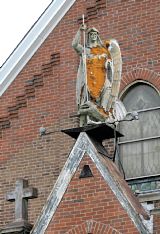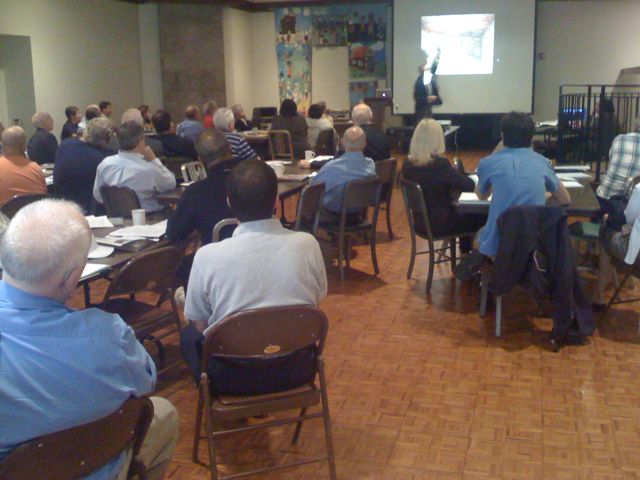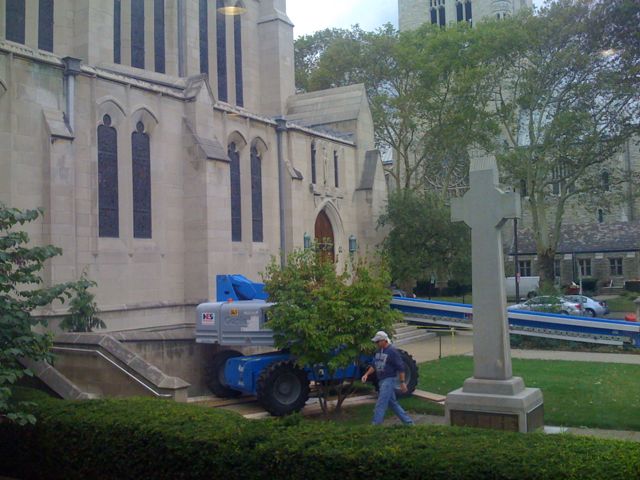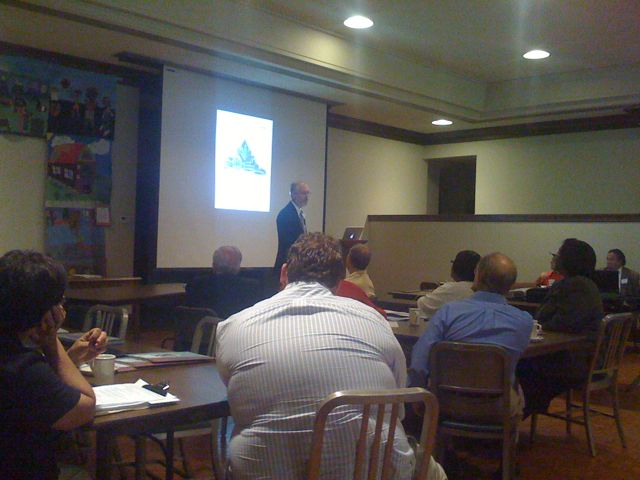
Category Archive: Religious Properties
-
Public Hearing Before Historic Review Commission on 4420 Bayard Street
PREPARED TESTIMONY OF
ANNE E. NELSON, ESQ.
GENERAL COUNSEL
PITTSBURGH HISTORY & LANDMARKS FOUNDATION
BEFORE HISTORIC REVIEW COMMISSION, CITY OF PITTSBURGH
PUBLIC HEARING ON 4420 BAYARD STREET, THE ELMHURST GROUP
OCTOBER 1, 2008
Pittsburgh History & Landmarks Foundation has reviewed the Elmhurst Group’s plans for a new office building in the parking lot behind and owned by the First Baptist Church in Oakland. We appreciate the very good efforts of the Elmhurst Group in regard to the planning and redesign of the structure. In particular, the building’s height, materials, and setback on Bayard Street are in accordance with the other buildings on the street and harmonize the building with the Church. The higher portion of the building along Ruskin Avenue complements the Ruskin Apartment and its materials and to some degree its style.
However, we have the following concerns with the building:
1. The top portion of the seven-story building should be redesigned without the projecting central overhang, which is something of a cliché in modern design. We also suggest that the stringcourse be continued across the Bayard/Bigelow façade just as it does on the Ruskin Avenue façade and with the elongated windows eliminated. We believe that such detailing is inappropriate next to the architecturally-significant First Baptist Church, the Ruskin Apartment Building and the houses of Schenley Farms.
2. We recommend that the walkway around the building be planted with sycamore trees instead of columnar trees as shown. We would be happy to meet with the City Forester to discuss the matter of tree selection. A few columnar trees were planted years ago further west on Bayard Street and they are still nothing more than elongated toothpicks with a few leaves attached. Sycamore trees, used throughout Schenley Farms, arch up over the streets and provide a canopy of elegance, beauty, and shade.
We continue also to have a significant concern with the Historic Review Commission’s jurisdiction and ability to review new construction in historic districts. We hope this matter can be resolved or clarified so as not to cause issues with other new construction projects in historic districts.
-
Technical Assistance Workshop for Guardians of Historic Religious Properties
PHLF News
September 5, 2008On Monday, September 15, the Historic Religious Properties Committee of Pittsburgh History & Landmarks Foundation (PHLF) will host a technical assistance workshop at Calvary Episcopal Church, 315 Shady Avenue, from 9:30 a.m. to 3:00 p.m. Congregation leaders, representatives, and guardians of historic religious properties in Allegheny County are invited to attend. The workshop fee of $25 includes box lunches for up to three people.
“Historic religious properties play a significant role in the spiritual, social, cultural and educational life of this region,” says George C. Dorman, Chair of PHLF’s Historic Religious Properties Committee, “and we know how difficult it is for congregations with limited budgets to preserve and maintain their architecturally-significant historic structures. Therefore, it is our goal to help these congregations by offering this workshop that will answer questions they may have and help them care for their buildings.”
This workshop will give congregation leaders an opportunity to speak with professionals in the field of building construction and maintenance.
Experts will speak on:
• Prioritizing building projects;
• Planning and organizing building projects;
• Financing a project: raising funds, seeking grants and loans;
• Working with contractors, getting bids and estimates, contracting the work;
• Stained glass window restoration, masonry work, roof and gutter replacement and repair;
• Energy conservation in large structures.Historic Religious Properties Technical Assistance Workshop
The workshop will feature assistance in prioritizing, planning, and organizing building projects; financing a project; working with contractors; specific building maintenance issues; and energy conservation in large structures. You will have the opportunity to ask questions of the presenters and network with other church leaders.
When you come, please bring a list of questions and photos of your structures demonstrating areas where maintenance is needed and where you have successfully done work.
Plenty of off-street parking is available in Calvary Episcopal Church’s parking lot.
- Time: 10:00 a.m.
to 3:00 p.m. - Meeting Location: Calvary Episcopal Church, 315 Shady Avenue. (Google Street View Map)
- Fee : $25, includes up to 3 people from your church or synagogue and box lunches.
- RSVP one day before this event. Contact Carole Malakoff, Historic Religious Properties Coordinator at hrp@phlf.org.
Program Agenda:
- 9:30: Coffee and Registration
- 10:00: Welcome
- Mark Bibro, Chairman, PHLF Board of Trustees
- George C. Dorman, Chairman, PHLF Historic Religious Properties Committee
- Arthur Ziegler, President, PHLF
- Tom Keffer, Property & Construction Manager, PHLF
- 10:30: Jack Scalo and Jacqui McMenamin, Burns and Scalo Roofing (dealing with roof problems)
- 11:00: John Kelly, Kelly Art Glass (preservation and maintenance of stained glass windows)
- 11:30: David Hounshell, member, First Methodist Church of Pittsburgh and professor, CMU Departments of History and Social & Decision Sciences (planning and organizing a church building project)
- 12:00: Sister Florence Lynch, CEO, Angels in Overalls; Jack Miller, PHLF (organizing a project and the role of volunteers)
- 12:30: Lunch
- 1:15: Greg Smith, Keystone Waterproofing; Aaron Wolk, Cathedral Stone Products (brick and masonry preservation)
- 1:45: Greg Wozniak––G. A. Wozniak & Assos., Energy Management & Consulting
(conserving energy in historic religious structures)
- 2:15: Susan Brandt, PHLF Trustee (searching for grants and loans: approaching funding sources)
Some photos of the workshop in progress.
- Time: 10:00 a.m.
-
Parishioners Decry Demolished 157-Year-Old Church in Elizabeth
WTAE
August 26, 2008A wrecking ball demolished a 157-year-old church in Elizabeth on Monday after decades of debate over the building’s future.
St. Michael the Archangel Church, built in 1851, closed its doors in 1987 after the Pittsburgh Diocese deemed the structure unsafe.
Long-time parishioners told WTAE Channel 4’s Jon Greiner Monday night that they believed the structure withstood time well.
"It was for the coal miners and the ship builders from Elizabeth. It stood up during the Civil War and here we are closing it," said Susan Sopko, a former parishioner. "It’s an historic landmark." A group of parishioners tried unsuccessfully to save the church, even offering to buy it, which the diocese turned down.
"That’s not what I wanted to see. We would rather have kept it a historical monument and a chapel of convenience," said J.C. Natale, a former parishioner. "We tried for 21 years and this is the end result."
Arnold Shaner took pictures of the demolition. He and five siblings were all baptized and married in the church."There’s a lot of memories in there. I was a wee guy. My mom used to sing at weddings," he said. "I spent a lot of hours in that church."
Shaner’s mother also drew the design for what was to become the Archangel Michael that stood guard over the church for decades — a guardian who is scheduled to come down Tuesday with the steeple and remainder of the church.
The Save Our Church group said its members plan further investigate the church was actually torn down without proper permits.
-
Group wants to save 1815 church in Elizabeth Borough from demolition
Thursday, August 07, 2008
By Mary Niederberger,
Pittsburgh Post-GazetteBut it’s unlikely that the angel, considered the guardian and protector of the church that was built in 1851, will be able to save the building from the wrecking ball, even though some former parishioners would like to buy it. The church shut its doors 21 years ago when the parish built a new church several miles away in Elizabeth Township.
The July 20 announcement that the former church would be demolished appears to be creating some of the same angst and outcry that its closing caused in 1987, when a group of parishioners sued the diocese unsuccessfully in an effort to keep it open.
But St. Michael pastor, the Rev. Rudolph Smoley, said the former St. Michael building must be razed for safety reasons because the structural deterioration that has taken place.
He said the decision to demolish the church was made after he and diocesan officials toured the church in September after local building inspector Arlo Roma noticed that a retaining wall outside of the church was learning toward the street and a church wall appeared to be crooked.
The Rev. Smoley said one of the stations of the cross inside of the church had fallen off of the wall with chunks of plaster coming along with it. “When I went in a month ago, a second station had fallen and was in pieces. Each of these sections of plaster is going to continue to fall like dominoes. The inside of the church is just literally crumbling,” the pastor said.
He said that he and diocesan officials are worried that part of the church could collapse and harm someone, particularly children who play in the area.
Church officials have filed an application with Elizabeth Borough for a demolition permit. Borough Secretary Robin Stockton said the borough is waiting for documentation from the church and that all utility service to the building has been shut off.
But some former parishioners, who were part of the lawsuit against the diocese when the former St. Michael church was closed, don’t agree with the assessment that the Rev. Smoley and diocesan officials have reached.
Some of them entered the church July 23 for the first time since it had closed. That night, a company that contracted with the diocese was removing religious items from the church to be sold on consignment. Other religious items from the former church have been taken to the current St. Michael Church.
The items were being removed in preparation for asbestos abatement work in the church that has since been completed.
Though the Rev. Smoley had opened the church July 23 and was supervising the activity, some of the former parishioners called police to the scene. Elizabeth Borough police took no action after they saw that no break-in or theft was taking place.
J.C. Natale, who was a member of parish council at the time the former church was closed and also a member of the Save Our Church group that sued the diocese, said he went to the site Wednesday and was upset to see so many of the religious items had been removed from the church.
Still, he said, he believes the church could be reopened and used as a “chapel of convenience,” a place where a Mass could be said perhaps once a week or an occasional baptism or wedding held.
“When I went inside of there, there wasn’t even a musty smell. Some plaster had fallen because of a clogged gutter, but that was about it. You could have held Mass in there if you wanted,” Mr. Natale said.
He said diocese officials said the building was structurally unsound in 1987 when it was closed. “It’s been 21 years. I think it would have collapsed by now if it were going to collapse,” he said.
Susan Sopko, another Save Our Church member, said she would like to see the church reopened and some of the religious items that were removed from it returned.
Mr. Sopko and Mr. Natale are among a group of former St. Michael parishioners who meet each Monday night to say the rosary outside of the former church building.
Arthur Ziegler, president of the Pittsburgh History & Landmarks Foundation, said a plaque was awarded to the church when it was closed in 1987 to mark its architectural significance. “But the plaque has no legal binding,” Mr. Ziegler said. “It cannot prevent the building from being torn down.”
Former parishioner Robert LaFrankie, who now lives in Bethlehem, Pa., has in recent years sent a proposal to the diocese — first to former Bishop Donald Wuerl and recently to Bishop David Zubik — to turn the former St. Michael Church into a Catholic “museum and education/learning center.” That proposal has not been acted upon.
Mary Von Fosson, an Elizabeth Borough council member, said the building inspector who contacted the Rev. Smoley with concerns about the church last year no longer works for the borough and did not tell council about his concerns.
Mrs. Von Fosson said council was not a party to the decision to raze the church. “The only thing that council ever discussed about St. Michael is the wall facing Fifth Street needs to be fixed because it was falling down. That doesn’t have anything to do with the church itself,” she said.
Despite the protests and pleas from the Save Our Church members, some of the stained glass windows have been removed from the former church and it is being readied for demolition. The windows will be installed in the chapel area of the current St. Michael Church.
On Tuesday, Mr. Natale and Gerald LaFrankie, Robert’s brother, faxed a letter to Bishop Zubik and the Rev. Smoley asking for time to have an appraisal done of the former church building so that the Save Our Church group can make a formal offer to purchase it.
But the Rev. Smoley said the process toward demolition will not be halted.
“This process is moving forward,” the Rev. Smoley said. “It is a safety issue.”
The St. Michael School building adjacent to the former church will remain open for CCD classes, the Rev. Smoley said. The school was closed in June due to declining enrollment.
 Mary Niederberger can be reached at mniederberger@post-gazette.com or 412-851-1512.First published on August 7, 2008 at 6:23 am
Mary Niederberger can be reached at mniederberger@post-gazette.com or 412-851-1512.First published on August 7, 2008 at 6:23 am -
Former church in West Tarentum caught up in fraud scandal
By Celanie Polanick
VALLEY NEWS DISPATCH
Thursday, July 3, 2008A former Roman Catholic church in West Tarentum was one of two in the Greater Pittsburgh area bought by Raffaello Follieri, an Italian real estate mogul recently accused of fraud for pretending to work for the Vatican.A century ago, St. Clement’s Church on West Ninth Avenue and Center Street was beautiful and beloved, filled with a blossoming faith community, according to historical accounts. But, like so many other churches, membership declined over the decades.After St. Clement’s closed in 2006, one of Follieri’s numerous corporations — CV12 216 W. Ninth Avenue LLC — bought the property in January 2007.
Follieri was arrested last week by federal investigators and accused of improperly spending money from investors, who believed he represented the Vatican’s financial and land interests.Now, local officials say, they’re not sure what will happen to St. Clement’s.Men from the Vatican
According to the U.S. Attorney’s Office, from June 2005 through June 2007, Follieri ran a fraudulent real estate investment scheme, claiming that he had close connections with the Vatican — enabling him to purchase Catholic church properties at prices well below their market value.
He allegedly told people he formally was appointed by the Vatican to manage its financial affairs. Investigators say he raised investment capital for an “Italian office” that didn’t exist, including $800,000 on bogus “engineering reports” and other falsified business expenses.
Federal prosecutors say they have ample evidence that he spent as much as $6 million from his investors on a jet-setting lifestyle for himself, a girlfriend and others. The girlfriend is said to be actress Anne Hathaway, who dated Follieri for four years. Tabloid reports say the pair split last week.
Follieri is charged with various counts of conspiracy, wire fraud and money laundering. If he receives the maximum sentence, Follieri would spend life in prison and pay millions of dollars in fines.
A federal district court judge set Follieri’s bail at $21 million — $16 million must be in cash or property. Follieri also must relinquish his passport and get five other people to co-sign, assuming responsibility if he tries to escape. At press time, he was still in federal custody.
Undervalued
When Follieri’s company bought the former St. Clement’s property from the Catholic Diocese of Pittsburgh in January 2007, it was valued at $407, 000 — $337,000 for the building and $70,000 for the 23,000 square feet of adjoining land. Follieri, though, paid only $252,000 for it, according to Allegheny County records.
Follieri’s company also bought St. Patrick’s in Alpsville, Allegheny County, said the Rev. Ron Lengwin, diocesan spokesman.
“We were prepared to sell them (other unused properties), but it never got that far,” Lengwin said.
Follieri’s representatives did not tell diocesan officials they had ties to the Vatican, said Lengwin.
“Any church official could tell who was from the Vatican and who was not,” he said.
The property was sold to Follieri at the reduced price because “when you sell a piece of property that no one else wants, you have to sell it to the person who wants to buy it for what they’re willing to pay,” Lengwin said.
By the end of the year, the property was back on the market for $425,000.
The marketing agent trying to sell it, James Kelly of Grubb & Ellis in Pittsburgh, said he could not comment, as part of his contract with Follieri’s company.
Multiple calls to Follieri Group’s main switchboard were forwarded by a receptionist to a non-working number.
Tarentum Borough Manager Bill Rossey said he had heard about Follieri but didn’t know he owned the former St. Clement’s property and had heard nothing about what might happen to it now.
According to staff at the U.S. Marshals’ Department of Asset Forfeiture, if Follieri is convicted of obtaining his assets fraudulently or using legitimately obtained assets to commit a crime, those assets could be seized and sold to pay restitution to the people he cheated. Other options include a plea agreement to sell the properties and liquidate the assets to pay restitution or other penalties.
At last estimate, the building needs about $400,000 in work before it could be used again, including the roof and mildew removal, said local Catholic historian Charles “Skip” Culleiton of New Kensington.
Former parishioners and local Catholics probably would like to see the building used to provide some social service or for another purpose that could improve the community, which is what Follieri’s corporation originally promised, Culleiton said.
“That would probably make (parishoners, Catholics) them feel better about the whole thing,” Culleiton said.
Celanie Polanick can be reached atcpolanick@tribweb.com or 724-226-4702
-
Public Hearing on St. Mary’s Academy Building
PREPARED TESTIMONY OF
ANNE E. NELSON, ESQ.
GENERAL COUNSEL
PITTSBURGH HISTORY & LANDMARKS FOUNDATION
BEFORE HISTORIC REVIEW COMMISSION, CITY OF PITTSBURGH
PUBLIC HEARING ON ST. MARY’S ACADEMY BUILDING
CITY HISTORIC STRUCTURE NOMINATION
JULY 2, 2008
Pittsburgh History & Landmarks Foundation (Landmarks) strongly supports the nomination of the Academy Building of the St. Mary’s Church complex to become a City-Designated Historic Structure.
The St. Mary’s Academy Building was listed on the first county-wide architectural survey conducted in the United States, undertaken by Landmarks in 1966, and chosen as one of the buildings published in Landmark Architecture of Allegheny County Pennsylvania by James D. Van Trump and Arthur P. Ziegler, Jr. The Academy Building was also listed in 1979 in the second countywide survey of historic architectural sites conducted by Landmarks, in association with the Commonwealth of Pennsylvania. It was chosen for inclusion as one of 600 out of the 10,000 surveyed in the major book based on this survey, Pittsburgh’s Landmark Architecture by Walter C. Kidney, published in 1997. Both Van Trump and Kidney consider the Greek Revival c. 1850 Academy Building a significant surviving example of an important American architectural style. Furthermore, its “curious ornamental cast iron porch” is “the sort usually associated with New Orleans or Mobile although once common too in the industrial North.”
In 1989 historian Roger Kennedy noted in his National Trust book Greek Revival America: “The Northern Greek Revival was at least as vigorous and diverse as that in the antebellum South; but all the great houses of the North … have fallen victim to that region’s industrial success.” This is also true of banks, courthouses, and modest Greek Revival structures like St. Mary’s Academy, and we should protect the limited number of survivors.
Of the buildings in the St. Mary’s Church complex, the Academy Building is not only the oldest, but is the most architecturally unique and should, therefore, be deemed a City-Historic Structure.
-
Downtown Concerts to be held at Historic Churches
The Pittsburgh Festival Orchestra’s Bach Lunch Concerts Summer Series will be conducted at two historic downtown Pittsburgh churches.
Featured June 17 will be the Pittsburgh Festival Orchestra Strings at Smithfield United Church of Christ.
On July 22, Gretchen van Hoesen (harp) and Jim Gorton (oboe) will perform at First Lutheran Church.
Finally, August 12, Sean Jones (trumpet) will also perform at First Lutheran Church.
For more information regarding times and cost, please contact pgh.bachs.lunch@gmail.com or call 412-736-3678.
-
Bethel AME marks 200th birthday
By Craig Smith
TRIBUNE-REVIEW
Monday, June 2, 2008Katie Everette Johnson’s pastor asked her to accompany him to a meeting with then-Pittsburgh Mayor David L. Lawrence because she took meticulous notes.It was a difficult assignment, recalled Johnson, now 85, of Schenley Heights.To make way for the Civic Arena, Lawrence said, the city would have to tear down the Bethel African Methodist Episcopal Church in the Hill District, where Johnson had attended services for 14 years.
“Why our church?” she said, recalling the emotions of that meeting.
The Rev. John D. Bright, pastor, pleaded in vain to save the historic church, Johnson said. The building was razed in 1956.Bethel AME Church, which served as a station for the Underground Railroad, will celebrate its 200th birthday next week.
The birthday means a lot to the congregation, said the Rev. Nathaniel Colvin, pastor. Many remember the pain of losing their church to the wrecking ball, he said. Bethel AME will sponsor a week’s worth of events beginning Sunday.
“When you talk about losing a building, a church building, it’s like losing a family home,” Colvin said.
Bethel was the first African Methodist Episcopal Church west of the Allegheny Mountains and is the oldest black congregation in the city. Its roots were planted in 1808 in a house on Front Street, Downtown.
Chartered in 1818, the church would be located in a number of buildings over the next two centuries. Bethel started the area’s first school for black children in 1831 and was host for the state’s first civil rights convention in 1841.
“The African-American church, particularly a church like Bethel AME is like the glue that holds the soul of the community together: offering hope and the sobering truth of the challenges of putting life together in a world like ours today,” said Sarah L McMillen, assistant professor of sociology at Duquesne University.
The church served as one of the main stations of the Underground Railroad, a secret network that helped fugitive slaves reach sanctuary in free states or Canada years before slavery was abolished in the United States.
“We are very proud to know the African Methodist Episcopal Church has been in the community this long. It has endured the days of slavery and other hardships,” said the Rev. Robert Vaughn Webster, bishop of Bethel AME’s 3rd District, which includes Ohio, West Virginia and Western Pennsylvania.
Many families stuck with the church, one of the oldest in the district, through its moves. Bethel’s oldest member is 107 years old.
“The fact that this congregation has continued services for 200 years in several church buildings in several locations indicates the continuity of the African-American culture in Pittsburgh, its deep roots and its continuing new generations,” said Arthur Ziegler, president of the Pittsburgh History & Landmarks Foundation.
Craig Smith can be reached at csmith@tribweb.com or 412-380-5646.




